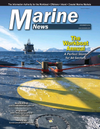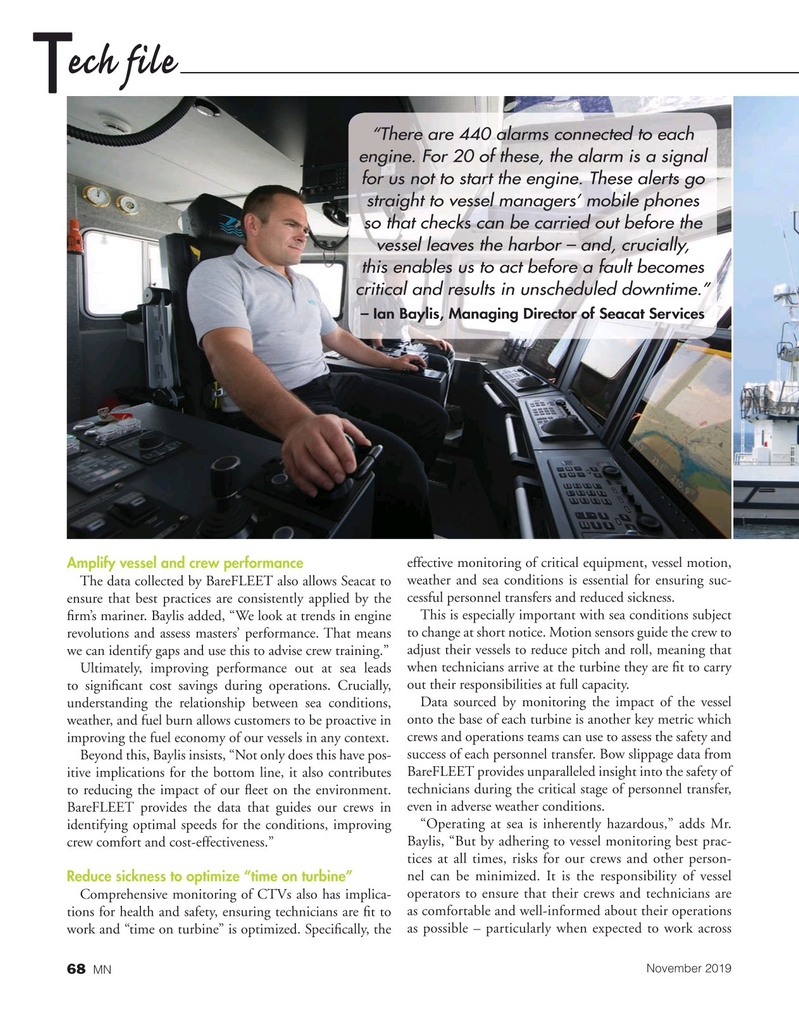
Page 68: of Marine News Magazine (November 2019)
Workboat Annual
Read this page in Pdf, Flash or Html5 edition of November 2019 Marine News Magazine
ech file
T “There are 440 alarms connected to each engine. For 20 of these, the alarm is a signal for us not to start the engine. These alerts go straight to vessel managers’ mobile phones so that checks can be carried out before the vessel leaves the harbor – and, crucially, this enables us to act before a fault becomes critical and results in unscheduled downtime.” – Ian Baylis, Managing Director of Seacat Services
Amplify vessel and crew performance effective monitoring of critical equipment, vessel motion,
The data collected by BareFLEET also allows Seacat to weather and sea conditions is essential for ensuring suc- ensure that best practices are consistently applied by the cessful personnel transfers and reduced sickness. ? rm’s mariner. Baylis added, “We look at trends in engine This is especially important with sea conditions subject revolutions and assess masters’ performance. That means to change at short notice. Motion sensors guide the crew to we can identify gaps and use this to advise crew training.” adjust their vessels to reduce pitch and roll, meaning that
Ultimately, improving performance out at sea leads when technicians arrive at the turbine they are ? t to carry to signi? cant cost savings during operations. Crucially, out their responsibilities at full capacity. understanding the relationship between sea conditions, Data sourced by monitoring the impact of the vessel weather, and fuel burn allows customers to be proactive in onto the base of each turbine is another key metric which improving the fuel economy of our vessels in any context. crews and operations teams can use to assess the safety and
Beyond this, Baylis insists, “Not only does this have pos- success of each personnel transfer. Bow slippage data from itive implications for the bottom line, it also contributes BareFLEET provides unparalleled insight into the safety of to reducing the impact of our ? eet on the environment. technicians during the critical stage of personnel transfer,
BareFLEET provides the data that guides our crews in even in adverse weather conditions. identifying optimal speeds for the conditions, improving “Operating at sea is inherently hazardous,” adds Mr. crew comfort and cost-effectiveness.” Baylis, “But by adhering to vessel monitoring best prac- tices at all times, risks for our crews and other person-
Reduce sickness to optimize “time on turbine” nel can be minimized. It is the responsibility of vessel
Comprehensive monitoring of CTVs also has implica- operators to ensure that their crews and technicians are tions for health and safety, ensuring technicians are ? t to as comfortable and well-informed about their operations work and “time on turbine” is optimized. Speci? cally, the as possible – particularly when expected to work across
November 2019
MN 68
MN Nov19 Layout 66-81.indd 68 MN Nov19 Layout 66-81.indd 68 10/28/2019 4:30:02 PM10/28/2019 4:30:02 PM

 67
67

 69
69
